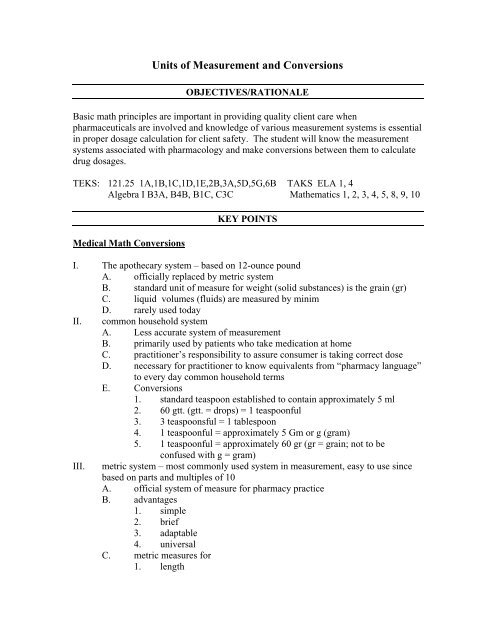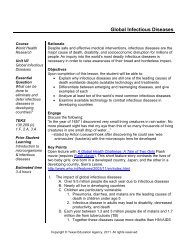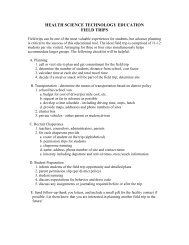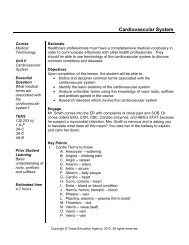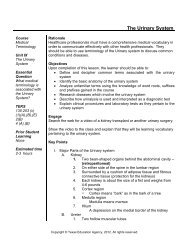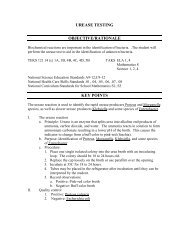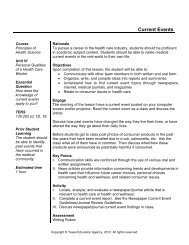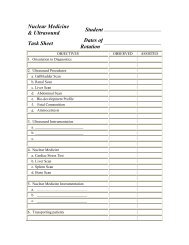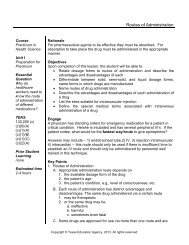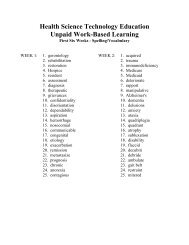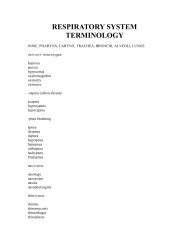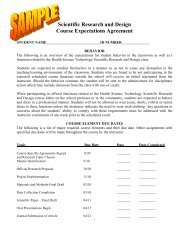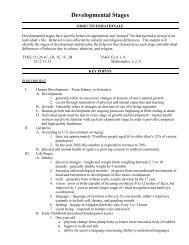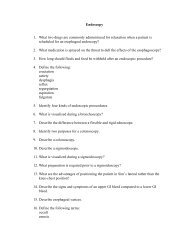Units of Measurement and Conversions - Haspi.org
Units of Measurement and Conversions - Haspi.org
Units of Measurement and Conversions - Haspi.org
Create successful ePaper yourself
Turn your PDF publications into a flip-book with our unique Google optimized e-Paper software.
<strong>Units</strong> <strong>of</strong> <strong>Measurement</strong> <strong>and</strong> <strong>Conversions</strong><br />
OBJECTIVES/RATIONALE<br />
Basic math principles are important in providing quality client care when<br />
pharmaceuticals are involved <strong>and</strong> knowledge <strong>of</strong> various measurement systems is essential<br />
in proper dosage calculation for client safety. The student will know the measurement<br />
systems associated with pharmacology <strong>and</strong> make conversions between them to calculate<br />
drug dosages.<br />
TEKS: 121.25 1A,1B,1C,1D,1E,2B,3A,5D,5G,6B TAKS ELA 1, 4<br />
Algebra I B3A, B4B, B1C, C3C Mathematics 1, 2, 3, 4, 5, 8, 9, 10<br />
Medical Math <strong>Conversions</strong><br />
KEY POINTS<br />
I. The apothecary system – based on 12-ounce pound<br />
A. <strong>of</strong>ficially replaced by metric system<br />
B. st<strong>and</strong>ard unit <strong>of</strong> measure for weight (solid substances) is the grain (gr)<br />
C. liquid volumes (fluids) are measured by minim<br />
D. rarely used today<br />
II. common household system<br />
A. Less accurate system <strong>of</strong> measurement<br />
B. primarily used by patients who take medication at home<br />
C. practitioner’s responsibility to assure consumer is taking correct dose<br />
D. necessary for practitioner to know equivalents from “pharmacy language”<br />
to every day common household terms<br />
E. <strong>Conversions</strong><br />
1. st<strong>and</strong>ard teaspoon established to contain approximately 5 ml<br />
2. 60 gtt. (gtt. = drops) = 1 teaspoonful<br />
3. 3 teaspoonsful = 1 tablespoon<br />
4. 1 teaspoonful = approximately 5 Gm or g (gram)<br />
5. 1 teaspoonful = approximately 60 gr (gr = grain; not to be<br />
confused with g = gram)<br />
III. metric system – most commonly used system in measurement, easy to use since<br />
based on parts <strong>and</strong> multiples <strong>of</strong> 10<br />
A. <strong>of</strong>ficial system <strong>of</strong> measure for pharmacy practice<br />
B. advantages<br />
1. simple<br />
2. brief<br />
3. adaptable<br />
4. universal<br />
C. metric measures for<br />
1. length
2. area<br />
3. volume<br />
4. weight<br />
5. temperature<br />
D. pharmacy mainly concerned with weights <strong>and</strong> volumes <strong>of</strong> drugs<br />
E. decimal system that can be divided into any parts that are multiple <strong>of</strong> 10<br />
(10, 100, 1000, etc.)<br />
F. Greek <strong>and</strong> Latin prefixes indicate what multiple is used, e.g. milli-, centi-,<br />
deci-, micro-, kilo-, etc.<br />
G. st<strong>and</strong>ard unit <strong>of</strong> metric measure for capacity or volume is liter<br />
H. st<strong>and</strong>ard unit <strong>of</strong> measure for weight is gram<br />
I. May encounter physician’s orders or prescriptions requiring conversion.<br />
1. within same system (e.g. convert 0.350 Gm to 350 mg – quantities<br />
both metric but using milligrams may be more convenient)<br />
2. from one system to another (e.g. 170 pounds to 77 kilograms<br />
because most drugs dosage requirements are determined by body<br />
weight in kg)<br />
3. translation from one system to another or within the same system<br />
is called conversion<br />
4. most physicians not cognizant <strong>of</strong> the various existing systems <strong>and</strong><br />
may write orders that appear to be jumbles quantities<br />
J. liquid drug preparations<br />
1. creams, <strong>and</strong> ointments are expressed as percentage concentrations<br />
2. a certain quantity <strong>of</strong> the drug is contained in the final quantity <strong>of</strong><br />
the product<br />
a. 1 % hydrocortisone cream contains 1 g <strong>of</strong> hydrocortisone in<br />
100 g final product (the actual drug plus the cream)<br />
b. 5% sodium chloride solution contains 5 g sodium chloride<br />
in 100 ml final product ( NaCl <strong>and</strong> distilled water)<br />
c. 1 gram in 100 grams or 1/100 equal to 0.01, or 1%<br />
d. 5 grams in 100 milliliters equal to 5/100 or 0.05, or 5%<br />
ACTIVITIES<br />
I. Complete Practice Problems.<br />
II. Complete Unit Equivalency Practice.<br />
III. Complete Dosage Calculations.<br />
IV. Review actual prescriptions, physician’s hospital orders, <strong>and</strong> /or bulk drug<br />
manufacturing requests that require decimals, ratio/proportion, <strong>and</strong> percentage<br />
calculations. Discuss, in small groups, the various systems used for drug<br />
calculations, determining preferences <strong>and</strong> justifying why.<br />
MATERIALS
Actual prescriptions <strong>and</strong>/or physician’s orders for medications (can be obtained from<br />
your physician or copies from hospital charts as long as information identifying patient<br />
<strong>and</strong> institution have been sufficiently obliterated – check with hospital administration if<br />
needed!)<br />
Conversion charts<br />
Successful completion calculation problems<br />
ASSESSMENT<br />
ACCOMMODATIONS<br />
For reinforcement, the student will review math conversation <strong>and</strong> complete the coherent<br />
sequence pretest.<br />
For enrichment, the student will develop health care related word <strong>and</strong> conversion<br />
problems directed to middle school mathematics. Include teaching aids to reinforce the<br />
relationship between measurements.<br />
REFLECTIONS
Dosage Calculations<br />
EXAMPLE: Scenario: The patient is to receive 1L <strong>of</strong> Lactated Ringer’s solution<br />
continuous IV q8hr. The primary administration set delivers 15 gtt/ml. At the<br />
beginning <strong>of</strong> the shift the 1L bag is found to contain 250 ml. When checking the drip<br />
rate you find the infusion to be running at 30 gtt/min. When will the next bag be due<br />
to be hung?<br />
This problem needs to be worked in two separate steps – the first one is to determine<br />
the rate required to infuse the ordered dose over the time specified. Remember that<br />
the scenario only states what you found – you always have to double check for<br />
yourself to ascertain accuracy! Whoever started this IV before your shift may have<br />
calculated incorrectly <strong>and</strong> if you do not correct the rate you will be responsible for<br />
any undesirable results as well!<br />
1. Find the pertinent solution required to solve the problem in the above scenario<br />
<strong>and</strong> mentally eliminate the rest.<br />
Pertinent information: 1 L/8 hrs (one entire dose); 15 gtt/ml; 30 gtt/min; 250<br />
ml/dose (remainder from whole dose)<br />
2. Determine what unit equivalency conversions you need.<br />
Unit equivalency conversion: 1000 ml/L; 60 min/hr<br />
3. Determine the desired units; what is the problem asking for?<br />
Desired units: (1) gtt/min; (2) time in hr <strong>and</strong>/or min
PRACTICE ROBLEMS<br />
Solve the following problems:<br />
1. How many cc in ½ tsp?<br />
2. Convert 20 gtt to cc.<br />
3. How many qt in 4 fl oz?<br />
4. Convert 1.5 inches to cm.<br />
5. Convert 0.05 g to μg.<br />
6. Convert 0.0025 L to cc.<br />
7. Convert 0.25 g to gr.<br />
8. Convert 1/40 gr to mg.<br />
9. How many tsp in 2 Tbs?<br />
10. Convert 88 lb to kg.<br />
Solve the following problems by making sure you list all the available information<br />
provided, extract the conversion factors from the information provided, <strong>and</strong> set up the<br />
conversion factors for the cancellation <strong>of</strong> the unwanted units.<br />
1. ordered: Furosemide 40 mg p.o<br />
available: Furosemide 20 mg tablets<br />
Calculate the number <strong>of</strong> tablets per dose<br />
2. ordered: Tylenol 500 mg p.o. stat.<br />
available: acetaminophen 500 mg tablets<br />
Calculate the number <strong>of</strong> tablets per dose<br />
3. ordered: Premarin 1.25 mg PO<br />
available: conjugated estrogens 0.625 mg tablets<br />
Calculate the number <strong>of</strong> tablets per dose<br />
4. ordered Procardia XL 60 mg b.i.d.<br />
available: Procardia XL 30 mg capsules<br />
Calculate the number <strong>of</strong> capsules per dose<br />
5. ordered: Biaxin 500 mg po bid<br />
available: Biaxin 250 mg tablets<br />
Calculate the number per dose
6. ordered: diphenhydramine 25 mg IM now<br />
available: Benadryl 50 mg/ml in 10 ml vial<br />
Calculate the number <strong>of</strong> ml/dose<br />
7. ordered: Epinephrine 0.3 mg SQ stat<br />
available: Epinephrine 1 mg/ml in 5 ml vial<br />
Calculate the number <strong>of</strong> ml per dose<br />
8. ordered: Fer-In-Sol 5 mg PO qd<br />
available: Fer-In-Sol 15 mg/0.6 cc<br />
Calculate the number <strong>of</strong> ml for a 90 d supply.<br />
9. ordered: Phenobarbital ¼ gr PO qid<br />
available: Phenobarbital 15 mg tablets<br />
Calculate the number <strong>of</strong> tablets/dose.<br />
10. ordered: Rocephin 1 g in 100 ml D 5 W IV b.i.d.<br />
available: Rocephin sterile crystalline 250 mg/vial<br />
Calculate the number <strong>of</strong> vials per dose.
Answer Key: Practice Problems<br />
1. 2.5 cc<br />
2. 1.3 cc<br />
3. 0.125 qt<br />
4. 3.81 cm<br />
5. 50,000 μg<br />
6. 2.5 cc<br />
7. 4.17 gr<br />
8. 1.5 mg<br />
9. 6 tsp<br />
10. 40 kg<br />
Dosage Problems:<br />
1. 40 mg/dose; 20 mg/tab; 40mg ; 20 mg 2 tab/dose<br />
dose tab<br />
2. 500 mg/dose; 500 mg/tab; 500 mg ; 500 mg 1 tab/dose<br />
dose tab<br />
3. 1.25 mg/dose; 0.625 mg/tab; 1.25 mg; 0.625mg 2 tab/dose<br />
dose tab<br />
4. 60 mg/dose; 30 mg/cap; 2 dose/d; 60 mg; 30 mg 2 cap/dose<br />
dose cap<br />
5. 500 mg/dose; 250 mg/tab; 2 dose/d; 500 mg; 250 mg 2 tab/dose<br />
dose tab<br />
6. 25 mg/dose; 50 mg/ml; 10 ml/vial; 25 mg; 50 mg ½ ml/dose<br />
dose ml<br />
7. 0.3 mg/dose; 1 mg/ml; 5 ml/vial; 0.3 mg; 1 mg 0.3 ml/dose<br />
dose ml<br />
8. 5 mg/dose; 15 mg/0.6 cc; 1 dose/d; 90 d; 5 mg ; 15 mg 18 cc<br />
dose 0.6 ml<br />
9. ¼ gr/dose; 15 mg tab; 4dose/d; 60 mg/gr (unit equivalence);<br />
1 gr; 15 mg; 60 mg; 1 tab/dose<br />
4 tab gr<br />
10. 1 g/dose; 1 g/100 ml; 250 ml/vial; 2 dose/d; 1000 mg/g (unit equivalence);<br />
1 g; 250 mg; 1000 mg 4 vial/dose<br />
dose vial 1 g
1. 1 g to mg<br />
2. 5 mg to μg<br />
3. 0.0025 L to ml<br />
4. 10 gr to mg<br />
5. 68 lb to kg<br />
6. 15 cc to tsp<br />
7. 500 cc to L<br />
8. 36.8 o C to o F<br />
9. 15 ml to Tbs<br />
10. 120 μgtt to cc<br />
11. 15 ml to gtt<br />
12. 1 fl oz to ml<br />
13. 2 gr to g<br />
14. 25 cc to ml<br />
15. 1 tsp to cc<br />
16. 10 km to ft<br />
17. 180 lb to kg<br />
18. 0.0005 mg to μg<br />
19. 500 μg to kg<br />
20. 98.6 o F to Celsius<br />
21. 25 gr to mg<br />
22. 1 hr to min<br />
23. 20 kg to lb<br />
24. 1 pt to fl oz<br />
25. 15 gtt to μgtt<br />
26. 1 pt to ml<br />
UNIT EQUIVALENCY PRACTICE<br />
Convert the following units:
ANSWER KEY TO UNIT EQUIVALENCY EXERSIZE<br />
1. 1 g = 1000 mg 1000 mg<br />
2. 1 mg = 1000 μg 5000 μg<br />
3. 1000 ml = 1 L 2.5 ml<br />
4. 60 mg = 1 gr 600 mg<br />
5. 2.2 lb = 1 kg 30.9 kg<br />
6. 5 cc = 1 tsp 3 tsp<br />
7. 1000 ml = 1 L, 1 cc = 1 ml 0.5 L<br />
8. 98.2 o F<br />
9. 5 ml = 1 tsp, 3 tsp = 1 Tbs 1 Tbs<br />
10. 1 ml = 60 μgtt 2 cc<br />
11. 1 ml = 15 gtt 225 gtt<br />
12. 1 fl oz = 30 ml 30 ml<br />
13. 1 gr = 60 mg, 1000 mg = 1 g 0.12 g<br />
14. 1 cc = 1 ml 25 ml<br />
15. 5 cc = 1 tsp 5 cc<br />
16. 2.54 cm = 1 in, 12 in = 1 ft 32,808.4 ft<br />
17. 2.2 lb = 1 kg 81.82 kg<br />
18. 1000 μg = 1mg 0.5 μg<br />
19. 1,000, 000 μg = 1 kg 0.0005 kg<br />
20. 37 o C<br />
21. 60 mg = 1 gr 1500 mg<br />
22. 60 min = 1 hr 60 min<br />
23. 2.2 lb = 1 kg 44 lb<br />
24. 16 fl oz = 1 pt 16 fl oz<br />
25. 1 ml = 15 gtt, 1 ml = 60 μgtt 60 μgtt<br />
26. 1 pt = 16 fl oz, 30 cc = 1 fl oz 480 ml


